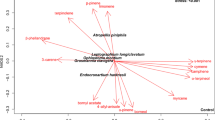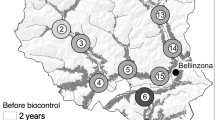Abstract
In winter 2000–2001, there was a serious outbreak of Gremmeniella abietina Morelet in southeastern Norway. During the outbreak, we noted that injured Scots pine trees (Pinus sylvestris L.) developed secondary buds in response to the fungus attack, and we decided to study the relationship between injury, appearance of secondary buds and recovery of the trees thereafter. For this purpose, 143 trees from 10 to 50 years of age were chosen and grouped into crown density classes. Injury was assessed in detail, and buds were counted before bud burst in the spring of 2002. In addition, a subset of 15 trees was followed through the summer of 2002 to assess recovery. All injured trees developed secondary buds, with a clear overweight of dormant winter buds in proportion to interfoliar buds. Healthy control trees did not develop secondary buds at all. The secondary buds appeared predominantly on the injured parts of the tree; interfoliar buds in particular developed just beneath the damaged tissue. Most of the secondary buds died during the winter of 2001–2002, mainly because the fungus continued to spread after the first outbreak. Many of the remaining buds developed shoots with abnormal growth during the summer. Secondary buds may help trees to recover from Gremmeniella attacks, but this strategy may fail when the fungus continues to grow and injure the newly formed buds and shoots.







Similar content being viewed by others
References
Aalto-Kallonen T, Kurkela T (1985) Gremmeniella disease and site factors affecting the condition and growth of Scots pine. Commun Inst For Fenn 126:1–28
Barklund P (1990) Gremmeniella abietina in Sweden: historical background and symptomatology of the disease. In: Kurkela A, Siwecki R (eds) Scots pine diseases, vol 360. Finnish Forest Research Institute, pp 55–58
Belyea HC, MacAloney HJ (1926) Weather injury to terminal buds of Scotch pine and other conifers. J For 24:685–690
Bjaanes H (2003) Furuas knopp-og greintørkesopp (Gremmeniella abietina). Skader og mottiltak i Hedmark 2001–2003. Rapport nr 09/03, Fylkesmannen i Hedmark, Landbruksavdelingen, Hamar, 16 pp + appendix (In Norwegian)
Borthwick AW (1899) On interfoliar buds in pines. Trans Proc Bot Soc Edinburgh 21:154–158
Braastad H (1980) Growth model computer program for Pinus sylvestris. Meddr Nor Inst Skogforsk 35:265–359 (In Norwegian with English summary)
Büsgen M, Münch E (1929) The structure and life of forest trees. Chapman and Hall, London
Butin H (1995) Tree diseases and disorders. Oxford University Press, Oxford
Cooperrider CK (1938) Recovery processes of Ponderosa pine reproduction following injury to young annual growth. Plant Physiol 13:5–27
Dickmann DI, Kozlowski TT (1968) Mobilization by Pinus resinosa cones and shoots of C14-photosynthate from needles of different ages. Am J Bot 55:900–906
Ericsson T (1991) Condition of Scots pine (Pinus sylvestris) and lodgepole pine (Pinus contorta) in Swedish Lapland, attacked by Gremmeniella fungus, three years after culmination of damage. Report no. 24, The Institute for Forest Improvement, Uppsala (In Swedish with English summary)
Graham SA, Baumhoffer LG (1930) Susceptibility of young pines to tip-moth injury. J For 28:54–65
Gremmen J (1972) Scleroderris lagerbergii Gr.: the pathogen and disease symptoms. Eur J For Path 2:1–5
Hellgren M (1995) Gremmeniella abietina: disease biology and genetic variation within Fennoscandia. Doctoral thesis, Department of Forest Mycology and Pathology, Swedish University of Agricultural Sciences, Uppsala
Junttila O, Heide OM (1981) Shoot and needle growth in Pinus sylvestris as related to temperature in Northern Fennoscandia. For Sci 27:423–430
Kienholz R (1933) Frost damage to Red pine. J For 31:392–399
Kozlowski TT (1971) Growth and development of trees. Seed germination, ontogeny, and shoot growth, vol 1. Academic, New York and London
Kozlowski TT, Keller T (1966) Food relations of woody plants. Bot Rev 32:293–382
Kozlowski TT, Winget CH (1964) The role of reserves in leaves, branches, stems, and roots on shoot growth of Red pine. Am J Bot 51:522–529
Kulman HM (1965) Effects of artificial defoliation of pine on subsequent shoot and needle growth. For Sci 11:90–98
Little CHA (1970) Apical dominance in long shoots of White pine (Pinus strobus). Can J Bot 48:239–253
Little S, Somes HA (1956) Buds enable pitch and shortleaf pines to recover from injury. Station paper no. 81, Northeast For Exp Stat, Upper Darby, Pennsylvania
McIntyre GI (1964) Mechanism of apical dominance in plants. Nature 203:1190–1191
McIntyre GI (1968) Nutritional control of the correlative inhibition between lateral shoots in the flax seedling (Linum usitatissimum). Can J Bot 46:147–155
Mirov NT (1967) The genus Pinus. The Ronald Press Company, New York
Montgomery DC (1984) Design and analysis of experiments, 2nd edn. Wiley, New York
Nakamura E (1964) Effect of decapitation and indole-3-acetic acid on the distribution of radioactive phosphorus in the stem of Pisum sativum. Plant Cell Physiol 5:521–524
Patton RF, Spear RN, Blenis PV (1984) The mode of infection and early stages of colonization of pines by Gremmeniella abietina. Eur J For Path 14:193–202
Read DJ (1968) Dieback disease of pines with special reference to Corsican pine (Pinus nigra) var. Calabrica Schn. III. Mycological factors. Forestry 41:72–82
Riihinen A, Uotila A (1992) Effect of Scleroderris canker on the growth of middle-aged Scots pine stands. Folia For 783:1–10 (In Finnish with English summary)
Roll-Hansen F, Roll-Hansen H, Skrøppa T (1992) Gremmeniella abietina, Phacidium infestans, and other causes of damage in alpine, young pine plantations in Norway. Eur J For Path 22:77–94
Siepmann R (1976) Ein Beitrag zur Infektionsbiologie des durch Scleroderris lagerbergii verursachten Schwarzkieferntriebsterbens. Eur J For Path 6:103–109
Sikström U, Jansson G, Weslien J (2005) Predicting the mortality of Pinus sylvestris attacked by Gremmeniella abietina and occurrence of Tomicus piniperda colonization. Can J For Res 35:860–867
Snedecor GW, Cochran WG (1967) Statistical methods. The Iowa State University Press, Ames, Iowa, USA
Stone Jr EL, Stone MH (1943) Dormant buds in certain species of Pinus. Am J Bot 30:346–351
UNECE/EC (United Nations Economic Commission for Europe-European Commission) 1998 Manual on methods and criteria for harmonized sampling, assessment, monitoring and analysis of the effects of air pollution on forests. Part II: Visual assessment of crown condition, 4th edn. Updated 2004, 15 pp + annexes
Uotila A (1983) Physiological and morphological variation among Finnish Gremmeniella abietina isolates. Commun Inst For Fenn 119:1–12
Ursino DJ, Nelson CD, Krotkov G (1968) Seasonal changes in the distribution of photo-assimilated14C in young pine plants. Plant Physiol 43:845–852
Wakeley PC (1928) Preliminary observations on the Pine tip moth (Rhyacionia frustrana Comst.) on southern pines. In: Transactions of the 4th International Congress on Entomology, Ithaca, vol 2, pp 865–868
Acknowledgements
This study was the M.Sc. thesis of G.S. at the Norwegian University of Life Sciences and was part of the project “Brown Scots Pine—Causes and Measures” financed by the Research Council of Norway, the Norwegian Forest Research Institute, NORSKOG, Skogbrand, and Skogtiltaksfondet. The County Governor of Hedmark county financed travel costs for G.S. Nicholas Clarke did linguistic improvements. The study was undertaken in forests owned by Jørgen J. Mathiesen, Torbjørn Gjølstad Jr., and Kjetil Aandstad. We thank the above-mentioned persons and institutions.
Author information
Authors and Affiliations
Corresponding author
Additional information
Communicated by W. Oßwald
Rights and permissions
About this article
Cite this article
Søgaard, G., Solheim, H. & Johnsen, Ø. Secondary buds in Scots pine trees infested with Gremmeniella abietina . Trees 21, 191–199 (2007). https://doi.org/10.1007/s00468-006-0111-1
Received:
Revised:
Accepted:
Published:
Issue Date:
DOI: https://doi.org/10.1007/s00468-006-0111-1




